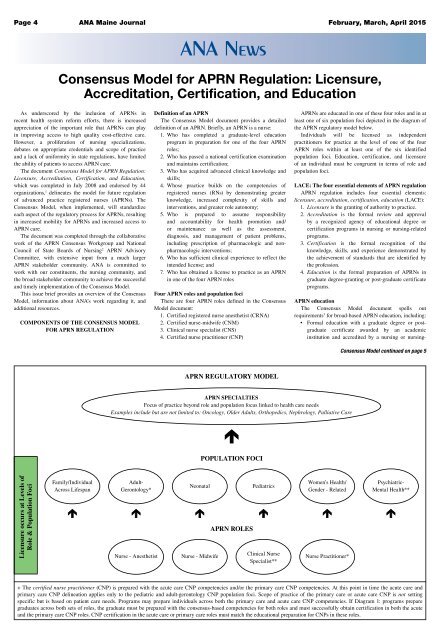ANA-Maine Journal - February 2015
Create successful ePaper yourself
Turn your PDF publications into a flip-book with our unique Google optimized e-Paper software.
Page 4 <strong>ANA</strong> <strong>Maine</strong> <strong>Journal</strong> <strong>February</strong>, March, April <strong>2015</strong><br />
<strong>ANA</strong> News<br />
Consensus Model for APRN Regulation: Licensure,<br />
Accreditation, Certification, and Education<br />
As underscored by the inclusion of APRNs in<br />
recent health system reform efforts, there is increased<br />
appreciation of the important role that APRNs can play<br />
in improving access to high quality cost-effective care.<br />
However, a proliferation of nursing specializations,<br />
debates on appropriate credentials and scope of practice<br />
and a lack of uniformity in state regulations, have limited<br />
the ability of patients to access APRN care.<br />
The document Consensus Model for APRN Regulation:<br />
Licensure, Accreditation, Certification, and Education,<br />
which was completed in July 2008 and endorsed by 44<br />
organizations, 1 delineates the model for future regulation<br />
of advanced practice registered nurses (APRNs). The<br />
Consensus Model, when implemented, will standardize<br />
each aspect of the regulatory process for APRNs, resulting<br />
in increased mobility for APRNs and increased access to<br />
APRN care.<br />
The document was completed through the collaborative<br />
work of the APRN Consensus Workgroup and National<br />
Council of State Boards of Nursing 2 APRN Advisory<br />
Committee, with extensive input from a much larger<br />
APRN stakeholder community. <strong>ANA</strong> is committed to<br />
work with our constituents, the nursing community, and<br />
the broad stakeholder community to achieve the successful<br />
and timely implementation of the Consensus Model.<br />
This issue brief provides an overview of the Consensus<br />
Model, information about <strong>ANA</strong>’s work regarding it, and<br />
additional resources.<br />
COMPONENTS OF THE CONSENSUS MODEL<br />
FOR APRN REGULATION<br />
Definition of an APRN<br />
The Consensus Model document provides a detailed<br />
definition of an APRN. Briefly, an APRN is a nurse:<br />
1. Who has completed a graduate-level education<br />
program in preparation for one of the four APRN<br />
roles;<br />
2. Who has passed a national certification examination<br />
and maintains certification;<br />
3. Who has acquired advanced clinical knowledge and<br />
skills;<br />
4. Whose practice builds on the competencies of<br />
registered nurses (RNs) by demonstrating greater<br />
knowledge, increased complexity of skills and<br />
interventions, and greater role autonomy;<br />
5. Who is prepared to assume responsibility<br />
and accountability for health promotion and/<br />
or maintenance as well as the assessment,<br />
diagnosis, and management of patient problems,<br />
including prescription of pharmacologic and nonpharmacologic<br />
interventions;<br />
6. Who has sufficient clinical experience to reflect the<br />
intended license; and<br />
7. Who has obtained a license to practice as an APRN<br />
in one of the four APRN roles<br />
Four APRN roles and population foci<br />
There are four APRN roles defined in the Consensus<br />
Model document:<br />
1. Certified registered nurse anesthetist (CRNA)<br />
2. Certified nurse-midwife (CNM)<br />
3. Clinical nurse specialist (CNS)<br />
4. Certified nurse practitioner (CNP)<br />
APRNs are educated in one of these four roles and in at<br />
least one of six population foci depicted in the diagram of<br />
the APRN regulatory model below.<br />
Individuals will be licensed as independent<br />
practitioners for practice at the level of one of the four<br />
APRN roles within at least one of the six identified<br />
population foci. Education, certification, and licensure<br />
of an individual must be congruent in terms of role and<br />
population foci.<br />
LACE: The four essential elements of APRN regulation<br />
APRN regulation includes four essential elements:<br />
licensure, accreditation, certification, education (LACE):<br />
1. Licensure is the granting of authority to practice.<br />
2. Accreditation is the formal review and approval<br />
by a recognized agency of educational degree or<br />
certification programs in nursing or nursing-related<br />
programs.<br />
3. Certification is the formal recognition of the<br />
knowledge, skills, and experience demonstrated by<br />
the achievement of standards that are identified by<br />
the profession.<br />
4. Education is the formal preparation of APRNs in<br />
graduate degree-granting or post-graduate certificate<br />
programs.<br />
APRN education<br />
The Consensus Model document spells out<br />
requirements 3 for broad-based APRN education, including:<br />
• Formal education with a graduate degree or postgraduate<br />
certificate awarded by an academic<br />
institution and accredited by a nursing or nursing-<br />
Consensus Model continued on page 5<br />
APRN REGULATORY MODEL<br />
APRN SPECIALTIES<br />
Focus of practice beyond role and population focus linked to health care needs<br />
Examples include but are not limited to: Oncology, Older Adults, Orthopedics, Nephrology, Palliative Care<br />
POPULATION FOCI<br />
Licensure occurs at Levels of<br />
Role & Population Foci<br />
Family/Individual<br />
Across Lifespan<br />
Adult-<br />
Gerontology*<br />
Nurse - Anesthetist<br />
Neonatal<br />
Nurse - Midwife<br />
APRN ROLES<br />
Pediatrics<br />
Clinical Nurse<br />
Specialist**<br />
Women’s Health/<br />
Gender - Related<br />
Nurse Practitioner*<br />
Psychiatric-<br />
Mental Health**<br />
+ The certified nurse practitioner (CNP) is prepared with the acute care CNP competencies and/or the primary care CNP competencies. At this point in time the acute care and<br />
primary care CNP delineation applies only to the pediatric and adult-gerontology CNP population foci. Scope of practice of the primary care or acute care CNP is not setting<br />
specific but is based on patient care needs. Programs may prepare individuals across both the primary care and acute care CNP competencies. If Diagram 1: programs prepare<br />
graduates across both sets of roles, the graduate must be prepared with the consensus-based competencies for both roles and must successfully obtain certification in both the acute<br />
and the primary care CNP roles. CNP certification in the acute care or primary care roles must match the educational preparation for CNPs in these roles.

















